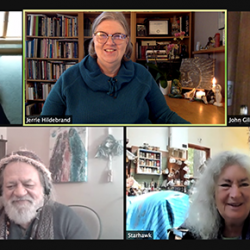 I am addressing a local lifelong learning institute this week on the subject of women in Unitarian Universalism. As I’ve worked on the preparations, I have ended up focused on the sea change within Unitarian Universalism following the 1977 Women and Religion resolution, and the organizing both before and after to reshape Unitarian Universalism into a more women-positive and feminist institution.
I am addressing a local lifelong learning institute this week on the subject of women in Unitarian Universalism. As I’ve worked on the preparations, I have ended up focused on the sea change within Unitarian Universalism following the 1977 Women and Religion resolution, and the organizing both before and after to reshape Unitarian Universalism into a more women-positive and feminist institution.
It’s hard to overstate the number of changes that this movement has wrought among us. Between 1968 and 1999, women went from being 2% of the actively serving ministers to becoming a majority. My main source for this work has been the book Leaping From Our Spheres: The Impact of Women on Unitarian Universalist Ministryi, a compilation of papers delivered to a conference of UU ministers in 1998, edited by Gretchen Woods. Various writers have raised up changes to the ministry and to Unitarian Universalism ranging from a more collegial and less competitive ministerial gatherings, to the use of mini-assemblies and other smaller group discussions at General Assembly, the introduction of the Water Ceremony and joys and concerns into Unitarian Universalist worship, and many others, which women either invented, popularized, or both.
This being a community group I am addressing, and which is made up mostly of non-Unitarian Universalists, I of course have to begin with an introduction to Unitarian Universalism. What can I say quickly to describe our faith to a group of people many of whom have never experienced it before? I go to two things: the Principles and the Sources.
Principles and Sources
The Principles, our covenant of what we will affirm and promote together:
The Sources of our “living tradition,” the places from which we draw wisdom and strength:
Both the Principles and the Sources, I realize, are what they are today because of the feminist movement within Unitarian Universalism, which demanded Principles in which women were represented, and which included a concern for the earth.
The last source, the one that we UU Pagans see ourselves in, “spiritual teachings of earth-centered traditions,” was added later than the other five, after this work on feminism within Unitarian Universalism had a bit of time to ferment. The route of recognition for Pagans within Unitarian Universalism came through the work of reclaiming female images of the divine, and the work on feminist theology that Unitarian Universalist women in ministry and laywomen did together in this period.
In 1986, a curriculum was published called Cakes for the Queen of Heaven. Written by Shirley Ranck, the curriculum examines pre-Judeo-Christian religions to see what worship of the feminine divine has looked like, while inviting participants to reflect on what it might mean to worship the feminine divine in their own lives.
This curriculum swept the UU world, and now we see Pagan traditions recognized as one of the sources of wisdom and strength for Unitarian Universalists. Now, after several decades, there are UU men who are part of the UU Pagan movement, and UUs of all genders who worship deities of all genders. But we are where we are within Unitarian Universalism because of the feminist movement.
The Principles, the Sources, the culture of General Assembly, the culture of UU ministerial gatherings, the things we think are important, the ways we talk about these things. All of this began to change in 1977 when we got serious about examining and rooting out sexism in Unitarian Universalism.
Gender vs Race
Remember that I said that in 1968, women were 2% of the actively serving ministers? In the book Leaping From Our Spheres, Rev. Dr. Michelle Bentley says, “In 1968, in the UUA, there were eight white female ministers and eight African American ministers, all male. In 1998, 35 years later, out of 1,333 total clergy, there were approximately 470 white female clergy…and 32 ministers of color, of which 21 are of African descent (14 male and seven female).”ii She asks us to consider the ways in which we have not adequately engaged in the dismantling of racism within Unitarian Universalism, at the same time as there was a concerted effort to dismantle sexism within Unitarian Universalism.
If the work to dismantle sexism in Unitarian Universalism (which is not complete, of course, but has made incredible strides) has had so many profound impacts on Unitarian Universalism, what might a similar commitment to dismantling racism create among us? This is a challenge we are asked to answer right now. If we meet this with the same intention and attention and commitment that we met this previous challenge, what would change? Our Principles? Our Sources? The culture of General Assembly? The culture of ministerial gatherings?
While some might read that list with fear, I hope that we as Pagan UUs might consider reading it with anticipation and excitement. After all, the last time Unitarian Universalism made space for such a sea change, it brought Paganism into Unitarian Universalism, among many other things. And I would argue that Unitarian Universalism is richer and deeper and more meaningful for the voice of Pagans among us. And so many of the other changes have also brought with them a new richness and depth and power and meaning.
So, what might be possible together if we got serious about dismantling racism among us and in our institutions? I think we will only know if we meet this moment with commitment and open hearts. I would love to know what might be created within Unitarian Universalism if we say yes to this present challenge!
i Leaping From Our Spheres, ed. Gretchen Woods, Generated by the UUMA CENTER Committee, 1998.
ii “Ain’t I a Woman?” by Rev. Dr. Michelle Bentley, in Leaping From Our Spheres, ed. Gretchen Woods, Generated by the UUMA CENTER Committee, 1998, pp. 149-150.

















